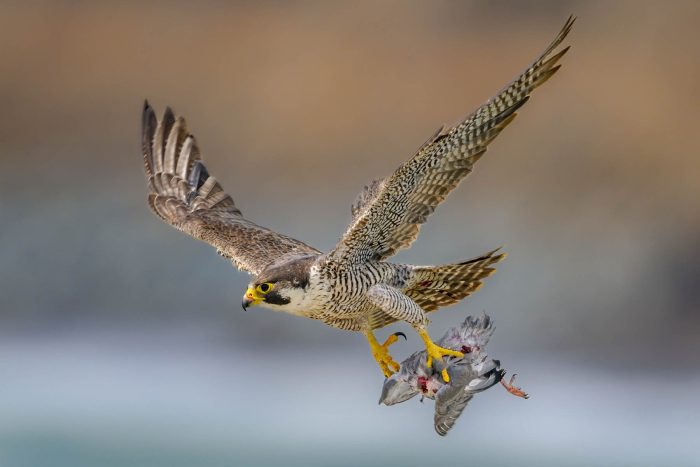Peregrine Falcon
Falco peregrinus
The peregrine falcon is a blue-gray raptor about the size of a crow. It has a black head and narrow black bars along its back and underside.
This section shows one large critter image at a time. Use the thumbnails that follow to select a specific image to display here.

This gallery contains a grid of small thumbnails. Selecting a thumbnail will change the main image in the preceding section.
Appearance
Peregrine falcons are approximately 15 to 20 inches in length and weigh about two pounds. The females tend to be slightly larger and as much as 50 percent heavier than the males. Mature falcons have a dark head and blue-gray wings, with horizontal black bars along their backs and white underside. Juveniles are more brown and have black vertical streaks rather than horizontal stripes. Peregrines have a wingspan of around 40 inches and narrow tails.
Feeding
Peregrine falcons prey primarily on other birds, including pigeons, doves, shorebirds and various waterfowl. They may occasionally eat small mammals or lizards. They hunt from a high perch and swoop down to capture prey with their talons. They then kill the prey with their beak and bring it back to the perch, to be eaten or stored for later.
Predators
Peregrine falcons have few predators but may occasionally be killed by larger raptors. Juveniles are also vulnerable to larger mammals, including bears and large cats.
Flight
Peregrine falcons fly at an average of around 30 miles per hour, but can reach speeds of up to 200 miles per hour when diving from high up. You can distinguish a peregrine in flight from other raptors by its long, pointed wings.
Voice
Most of the peregrine falcon’s sounds, including cheeps and chitters, are used during mating season. They make kack kack noises in response to potential danger, and sharp kee kee noises when hunting to mark their territory. Hungry young birds use screea sounds.
Reproduction and life cycle
Peregrine falcons often form monogamous bonds and return to the same nesting site year to year. They attract a mate by preening, vocalizing and performing impressive flying displays of dives, maneuvering and body rolls. Mates will sometimes gently clamp down on each other’s beaks, a display known as billing.
Once they have selected mates, the pair will breed sometime between March and May. They usually lay two to six red-brown eggs in May, in a high nest on cliffs, trees or buildings. The eggs hatch after about 35 days, usually in mid-June. Both the male and female are responsible for warming the eggs and taking care of the babies, though the female does more of the incubating. The juveniles learn to fly within one to two months of hatching, become independent within six weeks and fully mature after three years. Parent birds teach young fliers to hunt by dropping food through the air for them to chase and catch.
Did you know?
- The name peregrine means “wanderer.”
- Peregrine falcon populations were severely impacted by the pesticide DDT, which made their eggs thin and easily breakable. By the mid-1900s, there were no breeding pairs in the eastern United States. DDT has since been banned in the U.S. and the falcons have made a great comeback, including removal from the federal endangered species list. However, DDT and other similar pesticides are still used in some of the areas where peregrines may migrate for the winter.
- You can watch peregrine falcons on three area critter cams: Chesapeake Conservancy in Baltimore’s Inner Harbor; Virginia Department of Wildlife Resources in Richmond, Va.; and Pennsylvania Department of Environmental Protection in Harrisburg, Pa.
